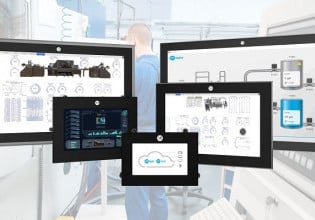Web-Based Industrial HMIs: What’s The Difference?
With the increasing appearance of “web-based” HMIs, we investigate these devices, learn how they differ from the graphical HMIs, and see implications for our modern control system architecture.
HMIs, or human-machine interfaces, are used in industrial automation systems to facilitate machine control. The common HMI systems we use today are radically different from the devices of the past. Original HMIs were batch interfaces, where all the inputs were given in advance with manual controls and basic data was generated only after all processing is done, perhaps on a 7-segment or CRT display.
Later, the standard shifted to the command-line interface where the operator had to input instructions. These instructions were similar to writing software code - not the most user-friendly way to operate a machine, especially for those industrial users. The graphical interfaces we use today originated in the 1980s, paving the way for the intuitive HMI systems we use extensively.
Today, the next evolution in HMIs is underway, towards web-based technologies. With this article, let us try to understand web-based HMIs (often called simply web panels) and how they differ from the graphical HMIs we love to use, and the implications of such HMIs in modern control system architecture.
IoT Impact on HMI Choices
The exponential advancements in electronics technologies have made a revolutionary impact on nearly every facet of our lives, also impacting industrial processes in the form of IoT devices. These internet-enabled devices collect massive amounts of data, relaying it to cloud computing infrastructure for storage and processing, readily accessible from any internet-enabled device.
Conventional HMI systems cannot handle such a large volume of data at nearly real-time transfer speeds. While conventional HMIs perform excellently in local networks, they might not be sufficient in an industry 4.0 paradigm. Dynamic and customizable HMI is imperative for IoT devices. This need gave rise to web-enabled HMIs. Such systems do not have proprietary software, but rather a tailored interface to suit the process and environment in which it is installed.

Figure 1. An IoT-enabled web panel, from the outside, still resembles the familiar look and feel of a graphical HMI. Image used courtesy of Maple Systems
Web-Based HMI Design
In lieu of proprietary software, an interface has to be designed, built, and deployed for web-enabled HMIs. This gives the opportunity to customize HMIs granularly. The interfaces are built using common web technologies such as HTML, CSS, and JavaScript. Popular frameworks like React, Angular, Vuejs, etc, can also be used to build the interface where templates are often available. The HMI interface will bear more similarities to modern smartphones and tablet app designs. Inputs and reactions can be customized according to the needs and requirements of the environment in which the device will be installed.
The frontend web framework only handles how information is displayed on the device. The data to be displayed is served to the HMI using an Application Programming Interface (API). An API facilitates communication between software applications. The data relayed over the network, through APIs, originates from the cloud computing infrastructure or from local servers, depending on how cloud-based a company might be. Another option is to display data directly from IoT sensors in real-time. The memory of modern HMIs can be used to store some historical data, sometimes quite a lot.
Although sensor input data is fed to web-based HMIs, controls can certainly still be sent to machines from HMIs. These instructions may communicate directly with actuators from the HMI. This is suitable only for actions that have to be performed with low latency but without much protection or safeguards. For actions that need safeguards, it is better to route instructions via cloud computing infrastructure or at least local servers. This is the function of an industrial PC (IPC), which might be comparable to the PLC in a graphical HMI system.
Graphical HMI vs Web-Based HMI
There are many facets of differences between the HMIs with graphical interfaces and web-based HMIs. Each of them has its own niche that suits its characteristics. Graphical HMIs are ideal for proprietary devices from the same OEM. For example, PanelViews from Rockwell Automation are ideal for working with PLCs from Rockwell itself. On the other hand, web-based HMIs are well-suited for devices that support open-source environments.

Figure 2. Graphical HMIs, such as this Phoenix Contact touch panel, can show vivid, detailed information. Image used courtesy of Phoenix Contact
Information exchange
Graphical HMIs have proprietary software, requiring information in proprietary formats to function. Such information is served from local controllers or servers directly. Often, this data arrives in the form of tags from specific PLCs, limiting the interoperability of various control system brands, unless the OEM has made specific allowances for various tag address structures.
Web-based HMIs use APIs to exchange information with a greater diversity of sources. With access to these APIs, developers create information exchanges in any manner as long as it adheres to the syntax and guidelines of APIs. The information is no longer coming from a single networked controller, but rather from a remote or cloud server, removing the restriction to using OEM-specific models.
Customizability
Graphical HMIs do often support a wide range of customizations, depending on software support from the OEM. Web-based HMIs, on the other hand, support complete customization. In fact, such devices do not work without developing and deploying custom interfaces. For applications that require immediate use and deployment, or regular on-site changes, perhaps conventional graphical HMIs are ideal.
Cybersecurity
Cybersecurity is a huge concern for industries in the current day and age. Each device in a plant has to be resilient to cyberattacks. Security for conventional graphical HMIs will depend on the OEM. If they are prompt in delivering security updates and patches, it is good. With web-based HMIs, each plant is responsible for cybersecurity. This is a great option for firms with strong technical capability.
Support
Graphical HMIs have support from OEMs and vendors, easily troubleshooting device problems. For web-based HMIs, the OEMs and vendors can only support the hardware. There is no support for the interface since it is developed externally. But since web-based HMIs use open-source software and frameworks, there is immense developer support available. Even in the design phase, developers can rely heavily on existing libraries and community support to build interfaces. But such support is limited only to software and not hardware, so web-based HMIs must rely on two different support systems.
Web-Based HMI in Existing Control Systems
Web-based HMIs might be considered more future-proof as they work well with IoT and other industry 4.0 technologies. It could seem prudent then to convert graphical HMIs to web-based HMIs for existing control systems. But by definition, the future is unknown. The decision to make a monumental shift in the machine interface has to be done only after a deep analysis of the future needs of the machine, the process, and the industry.

Figure 3. HMIs for web service as well as for direct controller interface are always available in a variety of common cabinet-mount sizes and depths. Image used courtesy of B&R Automation
Implementing web-based HMIs in existing control systems is technically feasible, but will depend greatly on OEM support and the software prowess of the firm. If your factory desires to be fitted with industry 4.0 technology, with data stored either on a local, remote, or cloud-based server, consider migrating to web-based HMIs. For facilities with exclusively local PLC-based control, perhaps graphical HMIs remain the better choice. All industries need not have industry 4.0 technologies. In such instances, it is better to continue with conventional HMIs.
Wrapping up
Web-based HMIs and conventional HMIs have their place in the industry. The ease and speed of commissioning graphical HMIs provide definite advantages. However, the range of customization and support for big data is a win for web-based HMIs. The choice of HMI will have an impact on a wide range of industrial processes, from day-to-day operations to safety. Careful inspection of needs must be done before opting for any HMI.






